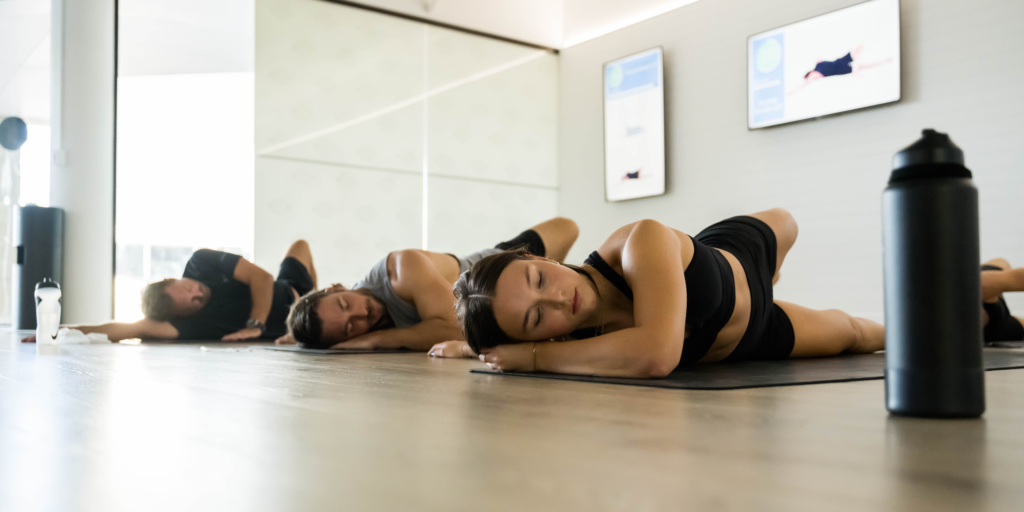What Is Active Recovery & The Benefits
If you exercise regularly and haven’t learned about the benefits of active recovery, it’s time to change that. We all know that a well-designed workout plan should account for rest days to allow your body to recover between training sessions – and active recovery is all about low impact exercises that assist the muscles with recovery more efficiently than passive rest. One of the reasons why FS8 can be so transformative to your workout plan is that active recovery is built into classes with cooldowns at the end of each session. To get the most out of your rest days, read on for everything you need to know about active recovery.
What is active recovery?
The term active recovery can sound like a contradiction, but taking steps to allow your body to recover properly between workouts isn’t just about passive rest. High energy training sessions are important for maintaining fitness, but during intense exercise oxygen levels can lower and cause the body to produce lactic acid. A build-up of too much lactic acid needs time to clear away – and this is where active recovery comes in.
So, how does active recovery work? Active recovery helps to pump blood around the body and speed lactic acid clearing. This process is helpful to implement in between sets, during interval training, immediately after a workout and on rest days. Let’s unpack the benefits of active recovery.
Benefits of active recovery
Daily movement is good for the body, so even on rest days some form of physical activity helps with overall health. Active recovery involves low intensity, low impact exercises that keep your body moving each day. These can be activities as simple as playing with a pet, or as personalised as targeted movements and exercises. The benefits of active recovery include:
- Promoting blood flow and the removal of lactic acid build-up.
- Helping to reduce soreness and tightness.
- Supporting the muscle rebuilding process.
- Workout routine maintenance.

How to practice active recovery
There are a number of ways to practice active recovery that are easy to build into your workout plan. Going for a walk or slow-paced bike ride are types of active recovery that can be social and relaxing. However, active recovery is also crucial during training and immediately post workout. For example:
- FS8 workouts build in time for a post session cooldown using foam rollers and stretching.
- During training like FS8 blast and FS8 OG classes, you can support recovery between sets by continuing movement with a gentle jog on the spot or stretching.
- If you prefer to attend workout classes focused on active recovery, yoga and pilates are ideal options.
If FS8’s holistic approach to active recovery sounds appealing to you, find an FS8 studio to book a class and check out what to expect to get prepared.
Yoga for recovery
Yoga is a form of exercise that can be customised to your needs on any particular day. FS8 instructors can provide ways to intensify each position or stretch, plus modifications for lower exertion. Slower, flow yoga sessions aimed towards recovery, like our FS8 Restore classes, can help reduce soreness and tightness by promoting blood flow and muscle repair between high intensity workouts. What’s more – yoga’s can help increase body awareness and support mobility and flexibility, all of which can enhance performance during more high intensity workouts.
Pilates for recovery
If you’ve done pilates before, you know it can help you work up a sweat – so you might be wondering ‘how is pilates active recovery?’ Pilates movements are low impact, so while they can be used in a high energy workout like our FS8 Remix classes, a slower approach is perfect for active recovery. Like yoga, pilates involves stretches that can encourage blood flow and support flexibility and mobility, but it can also help with strength building through the resistance element. In terms of what pilates can do for your body, its benefits go beyond active recovery, promoting body weighted strength training and engaging the muscles required for balance and tone.
Is active recovery better than rest?
While building rest days into your workout plan is important, how you use that rest time matters too. Passive rest can be necessary at times, and active recovery also has a place in any comprehensive workout schedule. While active recovery has a range of benefits that support your body and complement more strenuous workouts, it also helps in maintaining your fitness habits. Prioritising movement on rest days keeps you in the habit of training. Plus, exercise benefits your mental health and stress levels, which is important any day of the week.
Now you’re ready to adjust your training approach with active recovery. If you want to level up your workouts even more, read up on functional strength training and how it works.
